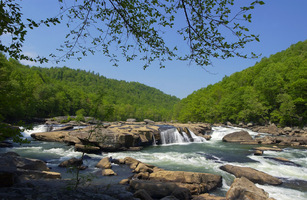 | Back to e-WV
| Back to e-WV
 The West Virginia Encyclopedia
The West Virginia Encyclopedia
 | Back to e-WV
| Back to e-WV
 The West Virginia Encyclopedia
The West Virginia Encyclopedia










Marion County lies in north-central West Virginia. The area was once part of the original vast Augusta County, Virginia, and was later split between Monongalia and Harrison counties.
Fairmont was established by the Virginia legislature on January 19, 1820, on the farm of Boaz Fleming. It became the county seat when Marion County was created in 1842. Fairmont is the home of Fairmont State University. The High Level Bridge in Fairmont opened in 1921.

Mannington was chartered as a town by the Virginia legislature in 1856 and by West Virginia in 1871. It was incorporated as a city in 1921.
Pricketts Fort was built in 1774 by Capt. Jacob Prickett. It was not a military fort, but a civilian refuge fort designed to shelter local settlers from Indian attack.

The Tygart Valley River is a major tributary of the Monongahela River. The source of the river is on Valley Mountain near the Randolph-Pocahontas county line.

The West Fork River traverses Marion, Harrison, Lewis, and Upshur counties.
The Monongahela River is formed at Fairmont by the merging of the West Fork and Tygart Valley rivers. The ‘‘Mon,’’ as it is often called by people of the region, terminates 128 miles away at Pittsburgh, where it joins the larger Allegheny to form the Ohio River.
On December 6, 1907, a massive explosion ripped through the Fairmont Coal Company’s No. 6 and 8 mines in Monongah. The powerful blast killed at least 361 men, making it the worst mine disaster in U.S. history.
On November 20, 1968, an explosion killed 78 men at Consolidation Coal Company’s No. 9 mine.
Eight miles below Grafton, the Tygart Valley River drops over an impressive series of falls. In 1964, this area was acquired by the state, with a total of 1,145 acres to become Valley Falls State Park. The park offers fishing, picnicking, game courts, and hiking trails, plus stone ruins providing an insight into the past.
